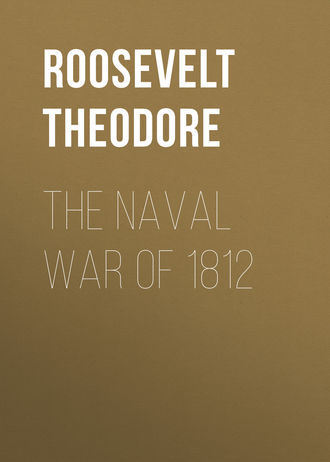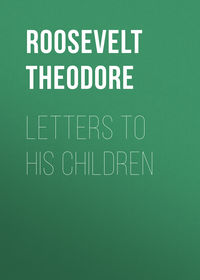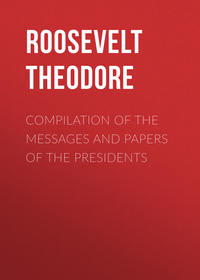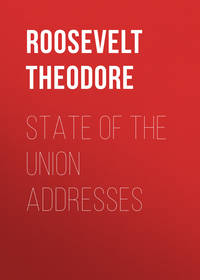 полная версия
полная версияThe Naval War of 1812
All the later American writers put the number of men in Barclay's fleet precisely at "502," but I have not been able to find out the original authority. James ("Naval Occurrences," p. 289) says the British had but 345, consisting of 50 seamen, 85 Canadians, and 210 soldiers. But the letter of Adjutant-General E. Bayne, Nov. 24, 1813, states that there were 250 soldiers aboard Barclay's squadron, of whom 23 were killed, 49 wounded, and the balance (178) captured; and James himself on a previous page (284) states that there were 102 Canadians on Barclay's vessels, not counting the Detroit, and we know that Barclay originally joined the squadron with 19 sailors from the Ontario fleet, and that subsequently 50 sailors came up from the Dover, James gives at the end of his "Naval Occurrences" some extracts from the court-martial held on Captain Barclay. Lieut. Thomas Stokes, of the Queen Charlotte, there testified that he had on board "between 120 and 130 men, officers and all together," of whom "16 came up from the Dover three days before." James, on p. 284, says her crew already consisted of 110 men; adding these 16 gives us 126 (almost exactly "between 120 and 130"). Lieutenant Stokes also testified that the Detroit had more men on account of being a larger and heavier vessel; to give her 150 is perfectly safe, as her heavier guns and larger size would at least need 24 men more than the Queen Charlotte. James gives the Lady Prevost 76, Hunter 39, Little Belt 15, and Chippeway 13 men, Canadians and soldiers, a total of 143; supposing that the number of British sailors placed on them was proportional to the amount placed on board the Queen Charlotte, we could add 21. This would make a grand total of 440 men, which must certainly be near the truth. This number is corroborated otherwise: General Bayne, as already quoted, says that there were aboard 250 soldiers, of whom 72 were killed or wounded. Barclay reports a total loss of 135, of whom 63 must therefore have been sailors or Canadians, and if the loss suffered by these bore the same proportion to their whole number as in the case of the soldiers, there ought to have been 219 sailors and Canadians, making in all 469 men. It can thus be said with certainty that there were between 440 and 490 men aboard, and I shall take the former number, though I have no doubt that this is too small. But it is not a point of very much importance, as the battle was fought largely at long range, where the number of men, provided there were plenty to handle the sails and guns, did not much matter. The following statement of the comparative force must therefore be very nearly accurate:
PERRY'S SQUADRON.

During the action, however, the Lawrence and Niagara each fought a long 12 instead of one of the carronades on the engaged side, making a broadside of 896 lbs., 288 lbs. being from long guns.
BARCLAY'S SQUADRON.

These six vessels thus threw at a broadside 459 lbs., of which 195 were from long guns.
The superiority of the Americans in long-gun metal was therefore nearly as three is to two, and in carronade metal greater than two to one. The chief fault to be found in the various American accounts is that they sedulously conceal the comparative weight of metal, while carefully specifying the number of guns. Thus, Lossing says: "Barclay had 35 long guns to Perry's 15, and possessed greatly the advantage in action at a distance"; which he certainly did not. The tonnage of the fleets is not so very important; the above tables are probably pretty nearly right. It is, I suppose, impossible to tell exactly the number of men in the two crews. Barclay almost certainly had more than the 440 men I have given him, but in all likelihood some of them were unfit for duty, and the number of his effectives was most probably somewhat less than Perry's. As the battle was fought in such smooth water, and part of the time at long range, this, as already said, does not much matter. The Niagara might be considered a match for the Detroit, and the Lawrence and Caledonia for the five other British vessels; so the Americans were certainly very greatly superior in force.
At daylight on Sept. 10th Barclay's squadron was discovered in the N. W., and Perry at once got under weigh; the wind soon shifted to the N. E., giving us the weather-gage, the breeze being very light. Barclay lay to in a close column, heading to the S. W in the following order: Chippeway, _Master's Mate J. Campbell; Detroit, Captain R. H. Barclay; Hunter, Lieutenant G. Bignall; Queen Charlotte, Captain R. Finnis; Lady Prevost, Lieutenant Edward Buchan; and Little Belt, by whom commanded is not said. Perry came down with the wind on his port beam, and made the attack in column ahead, obliquely. First in order came the Ariel, Lieut. John H. Packet, and Scorpion, Sailing-Master Stephen Champlin, both being on the weather bow of the Lawrence, Captain O. H. Perry; next came the Caledonia, Lieut. Daniel Turner; Niagara, Captain Jesse D. Elliott; Somers, Lieutenant A. H. M. Conklin; Porcupine, Acting Master George Serrat; Tigress, Sailing-Master Thomas C. Almy, and Trippe, Lieutenant Thomas Holdup. [Footnote: The accounts of the two commanders tally almost exactly. Barclay's letter is a model of its kind for candor and generosity. Letter of Captain R. H. Barclay to Sir James. Sept. 2, 1813; of Lieutenant Inglis to Captain Barclay, Sept. 10th; of Captain Perry to the Secretary of the Navy, Sept. 10th and Sept. 13th, and to General Harrison, Sept. 11th and Sept. 13th. I have relied mainly on Lossing's "Field-Book of the War of 1812" (especially for the diagrams furnished him by Commodore Champlin), on Commander Ward's "Naval Tactics," p. 76, and on Cooper's "Naval History." Extracts from the court-martial on Captain Barclay are given in James' "Naval Occurrences," lxxxiii.]
As, amid light and rather baffling winds, the American squadron approached the enemy, Perry's straggling line formed an angle of about fifteen degrees with the more compact one of his foes. At 11.45 the Detroit opened the action by a shot from her long 24, which fell short; at 11.50 she fired a second which went crashing through the Lawrence, and was replied to by the Scorpion's long 32. At 11.55 the Lawrence, having shifted her port bow-chaser, opened with both the long 12's, and at meridian began with her carronades, but the shot from the latter all fell short. At the same time the action became general on both sides, though the rearmost American vessels were almost beyond the range of their own guns, and quite out of range of the guns of their antagonists. Meanwhile the Lawrence was already suffering considerably as she bore down on the enemy.
[Illustration: The Battle of Lake Eire: a painting done for Thomas Brownell, sailing master of the Ariel, by George I. Cook in 1815-16. The composition was inspected for accuracy by Commodore Perry and three other officers as well as by Brownell himself, "all of whom," he wrote years later, "were in the battle, and in whose minds all its incidents, the positions of the fleets & appearance of the vessels was fresh. In the last two particulars the picture is the product of our joined opinions and recollections; it is, therefore, to be presumed that it is a correct representation of that naval combat." Here published for the first time, it depicts the second stage of the battle, in which Perry, having transferred his flag to the Niagara, brought the entire American squadron into action. The vessels, from left to right, are American unless denoted (Br): Lady Prevost (Br), Trippe, Chippeway (Br), Caledonia, Niagara, Detroit (Br), Queen Charlotte (Br), Hunter (Br), Scorpion, Ariel, Porcupine, and Lawrence. (Courtesy U.S. Naval Academy Museum)]
It was twenty minutes before she succeeded in getting within good carronade range, and during that time the action at the head of the line was between the long guns of the Chippeway and Detroit, throwing 123 pounds, and those of the Scorpion, Ariel, and Lawrence, throwing 104 pounds. As the enemy's fire was directed almost exclusively at the Lawrence she suffered a great deal. The Caledonia, Niagara, and Somers were meanwhile engaging, at long range, the Hunter and Queen Charlotte, opposing from their long guns 96 pounds to the 39 pounds of their antagonists, while from a distance the three other American gun-vessels engaged the Prevost and Little Belt. By 12.20 the Lawrence had worked down to close quarters, and at 12.30 the action was going on with great fury between her and her antagonists, within canister range. The raw and inexperienced American crews committed the same fault the British so often fell into on the ocean, and overloaded their carronades. In consequence, that of the Scorpion upset down the hatchway in the middle of the action, and the sides of the Detroit were dotted with marks from shot that did not penetrate. One of the Ariel's long 12's also burst. Barclay fought the Detroit exceedingly well, her guns being most excellently aimed, though they actually had to be discharged by flashing pistols at the touchholes, so deficient was the ship's equipment. Meanwhile the Caledonia came down too, but the Niagara was wretchedly handled, Elliott keeping at a distance which prevented the use either of his carronades or of those of the Queen Charlotte, his antagonist; the latter, however, suffered greatly from the long guns of the opposing schooners, and lost her gallant commander, Captain Finnis, and first lieutenant, Mr. Stokes, who were killed early in the action; her next in command, Provincial Lieutenant Irvine, perceiving that he could do no good, passed the Hunter and joined in the attack on the Lawrence, at close quarters. The Niagara, the most efficient and best-manned of the American vessels, was thus almost kept out of the action by her captain's misconduct. At the end of the line the fight went on at long range between the Somers, Tigress, Porcupine, and Trippe on one side, and Little Belt and Lady Prevost on the other; the Lady Prevost making a very noble fight, although her 12-pound carronades rendered her almost helpless against the long guns of the Americans. She was greatly cut up, her commander, Lieutenant Buchan, was dangerously, and her acting first lieutenant, Mr. Roulette, severely wounded, and she began falling gradually to leeward.
The fighting at the head of the line was fierce and bloody to an extraordinary degree. The Scorpion, Ariel, Lawrence, and Caledonia, all of them handled with the most determined courage, were opposed to the Chippeway, Detroit, Queen Charlotte, and Hunter, which were fought to the full as bravely. At such close quarters the two sides engaged on about equal terms, the Americans being superior in weight of metal, and inferior in number of men. But the Lawrence had received such damage in working down as to make the odds against Perry. On each side almost the whole fire was directed at the opposing large vessel or vessels; in consequence the Queen Charlotte was almost disabled, and the Detroit was also frightfully shattered, especially by the raking fire of the gun-boats, her first lieutenant, Mr. Garland, being mortally wounded, and Captain Barclay so severely injured that he was obliged to quit the deck, leaving his ship in the command of Lieutenant George Inglis. But on board the Lawrence matters had gone even worse, the combined fire of her adversaries having made the grimmest carnage on her decks. Of the 103 men who were fit for duty when she began the action, 83, or over four fifths, were killed or wounded. The vessel was shallow, and the ward-room, used as a cockpit, to which the wounded were taken, was mostly above water, and the shot came through it continually, killing and wounding many men under the hands of the surgeon.
The first lieutenant, Yarnall, was three times wounded, but kept to the deck through all; the only other lieutenant on board, Brooks, of the marines, was mortally wounded. Every brace and bowline was shot away, and the brig almost completely dismantled; her hull was shattered to pieces, many shot going completely through it, and the guns on the engaged side were by degrees all dismounted. Perry kept up the fight with splendid courage. As the crew fell one by one, the commodore called down through the skylight for one of the surgeon's assistants; and this call was repeated and obeyed till none were left; then he asked, "Can any of the wounded pull a rope?" and three or four of them crawled up on deck to lend a feeble hand in placing the last guns. Perry himself fired the last effective heavy gun, assisted only by the purser and chaplain. A man who did not possess his indomitable spirit would have then struck. Instead, however, although failing in the attack so far, Perry merely determined to win by new methods, and remodelled the line accordingly. Mr. Turner, in the Caledonia, when ordered to close, had put his helm up, run down on the opposing line, and engaged at very short range, though the brig was absolutely without quarters. The Niagara had thus become the next in line astern of the Lawrence, and the sloop Trippe, having passed the three schooners in front of her, was next ahead. The Niagara now, having a breeze, steered for the head of Barclay's line, passing over a quarter of a mile to windward of the Lawrence, on her port beam. She was almost uninjured, having so far taken very little part in the combat, and to her Perry shifted his flag. Leaping into a row boat, with his brother and four seamen, he rowed to the fresh brig, where he arrived at 2.30, and at once sent Elliott astern to hurry up the three schooners. The Trippe was now very near the Caledonia. The Lawrence, having but 14 sound men left, struck her colors, but could not be taken possession of before the action re-commenced. She drifted astern, the Caledonia passing between her and her foes. At 2.45, the schooners having closed up, Perry, in his fresh vessel, bore up to break Barclay's line.
The British ships had fought themselves to a standstill. The Lady Prevost was crippled and sagged to leeward, though ahead of the others. The Detroit and Queen Charlotte were so disabled that they could not effectually oppose fresh antagonists. There could thus be but little resistance to Perry, as the Niagara stood down, and broke the British line, firing her port guns into the Chippeway, Little Belt, and Lady Prevost, and the starboard ones into the Detroit, Queen Charlotte, and Hunter, raking on both sides. Too disabled to tack, the Detroit and Charlotte tried to wear, the latter running up to leeward of the former; and, both vessels having every brace and almost every stay shot away, they fell foul. The Niagara luffed athwart their bows, within half pistol-shot, keeping up a terrific discharge of great guns and musketry, while on the other side the British vessels were raked by the Caledonia and the schooners so closely that some of their grape shot, passing over the foe, rattled through Perry's spars. Nothing further could be done, and Barclay's flag was struck at 3 P.M., after three and a quarter hours' most gallant and desperate fighting. The Chippeway and Little Belt tried to escape, but were overtaken and brought to respectively by the Trippe and Scorpion, the commander of the latter, Mr. Stephen Champlin, firing the last, as he had the first, shot of the battle. "Captain Perry has behaved in the most humane and attentive manner, not only to myself and officers, but to all the wounded," writes Captain Barclay.
The American squadron had suffered severely, more than two thirds of the loss falling upon the Lawrence, which was reduced to the condition of a perfect wreck, her starboard bulwarks being completely beaten in. She had, as already stated, 22 men killed, including Lieutenant of Marines Brooks and Midshipman Lamb; and 61 wounded, including Lieutenant Yarnall, Midshipman (acting second lieutenant) Forrest, Sailing-Master Taylor, Purser Hambleton, and Midshipmen Swartout and Claxton. The Niagara lost 2 killed and 25 wounded (almost a fifth of her effectives), including among the latter the second lieutenant, Mr. Edwards, and Midshipman Cummings. The Caledonia had 3, the Somers 2, and Trippe 2, men wounded. The Ariel had 1 killed and 3 wounded; the Scorpion 2 killed, including Midshipman Lamb. The total loss was 123; 27 were killed and 96 wounded, of whom 3 died.
The British loss, falling most heavily on the Detroit and Queen Charlotte, amounted to 41 killed (including Capt. S. J. Garden, R.N., and Captain R. A. Finnis), and 94 wounded (including Captain Barclay and Lieutenants Stokes, Buchan, Rolette, and Bignall): in all 135. The first and second in command on every vessel were killed or wounded, a sufficient proof of the desperate nature of the defence.
[Illustration: The following diagrams will serve to explain the movements.]
[Illustration: 2 P.M.]
[Illustration: 2:30 P.M.]
The victory of Lake Erie was most important, both in its material results and in its moral effect. It gave us complete command of all the upper lakes, prevented any fears of invasion from that quarter, increased our prestige with the foe and our confidence in ourselves, and ensured the conquest of upper Canada; in all these respects its importance has not been overrated. But the "glory" acquired by it most certainly has been estimated at more than its worth. Most Americans, even the well educated, if asked which was the most glorious victory of the war, would point to this battle. Captain Perry's name is more widely known than that of any other commander. Every school-boy reads about him, if of no other sea-captain; yet he certainly stands on a lower grade than either Hull or Macdonough, and not a bit higher than a dozen others. On Lake Erie our seamen displayed great courage and skill; but so did their antagonists. The simple truth is, that, where on both sides the officers and men were equally brave and skilful, the side which possessed the superiority in force, in the proportion of three to two, could not well help winning. The courage with which the Lawrence was defended has hardly ever been surpassed, and may fairly be called heroic; but equal praise belongs to the men on board the Detroit, who had to discharge the great guns by flashing pistols at the touchholes, and yet made such a terribly effective defence. Courage is only one of the many elements which go to make up the character of a first-class commander; something more than bravery is needed before a leader can be really called great.
There happened to be circumstances which rendered the bragging of our writers over the victory somewhat plausible. Thus they could say with an appearance of truth that the enemy had 63 guns to our 54, and outnumbered us. In reality, as well as can be ascertained from the conflicting evidence, he was inferior in number; but a few men more or less mattered nothing. Both sides had men enough to work the guns and handle the ships, especially as the fight was in smooth water, and largely at long range. The important fact was that though we had nine guns less, yet, at a broadside, they threw half as much metal again as those of our antagonist. With such odds in our favor it would have been a disgrace to have been beaten. The water was too smooth for our two brigs to show at their best; but this very smoothness rendered our gun-boats more formidable than any of the British vessels, and the British testimony is unanimous, that it was to them the defeat was primarily due. The American fleet came into action in worse form than the hostile squadron, the ships straggling badly, either owing to Perry having formed his line badly, or else to his having failed to train the subordinate commanders how to keep their places. The Niagara was not fought well at first, Captain Elliott keeping her at a distance that prevented her from doing any damage to the vessels opposed, which were battered to pieces by the gun-boats without the chance of replying. It certainly seems as if the small vessels at the rear of the line should have been closer up, and in a position to render more effectual assistance; the attack was made in too loose order, and, whether it was the fault of Perry or of his subordinates, it fails to reflect credit on the Americans. Cooper, as usual, praises all concerned; but in this instance not with very good judgment. He says the line-of-battle was highly judicious, but this may be doubted. The weather was peculiarly suitable for the gun-boats, with their long, heavy guns; and yet the line-of-battle was so arranged as to keep them in the rear and let the brunt of the assault fall on the Lawrence, with her short carronades. Cooper again praises Perry for steering for the head of the enemy's line, but he could hardly have done any thing else. In this battle the firing seems to have been equally skilful on both sides, the Detroit's long guns being peculiarly well served; but the British captains manoeuvred better than their foes at first, and supported one another better, so that the disparity in damage done on each side was not equal to the disparity in force. The chief merit of the American commander and his followers was indomitable courage, and determination not to be beaten. This is no slight merit; but it may well be doubted if it would have ensured victory had Barclay's force been as strong as Perry's. Perry made a headlong attack; his superior force, whether through his fault or his misfortune can hardly be said, being brought into action in such a manner that the head of the line was crushed by the inferior force opposed. Being literally hammered out of his own ship, Perry brought up its powerful twin-sister, and the already shattered hostile squadron was crushed by sheer weight. The manoeuvres which marked the close of the battle, and which ensured the capture of all the opposing ships, were unquestionably very fine.
The British ships were fought as resolutely as their antagonists, not being surrendered till they were crippled and helpless, and almost all the officers, and a large proportion of the men placed hors de combat. Captain Barclay handled his ships like a first-rate seaman. It was impossible to arrange them so as to be superior to his antagonist, for the latter's force was of such a nature that in smooth water his gun-boats gave him a great advantage, while in any sea his two brigs were more than a match for the whole British squadron. In short, our victory was due to our heavy metal. As regards the honor of the affair, in spite of the amount of boasting it has given rise to, I should say it was a battle to be looked upon as in an equally high degree creditable to both sides. Indeed, if it were not for the fact that the victory was so complete, it might be said that the length of the contest and the trifling disparity in loss reflected rather the most credit on the British. Captain Perry showed indomitable pluck, and readiness to adapt himself to circumstances; but his claim to fame rests much less on his actual victory than on the way in which he prepared the fleet that was to win it. Here his energy and activity deserve all praise, not only for his success in collecting sailors and vessels and in building the two brigs, but above all for the manner in which he succeeded in getting them out on the lake. On that occasion he certainly out-generalled Barclay; indeed the latter committed an error that the skill and address he subsequently showed could not retrieve. But it will always be a source of surprise that the American public should have so glorified Perry's victory over an inferior force, and have paid comparatively little attention to Macdonough's victory, which really was won against decided odds in ships, men, and metal.











